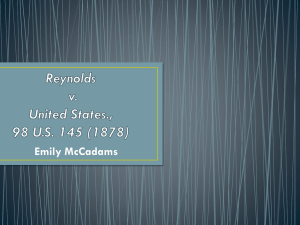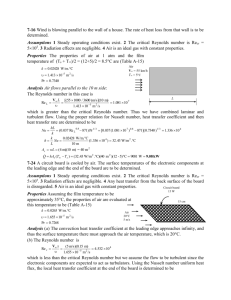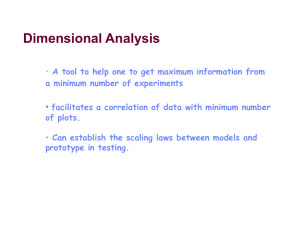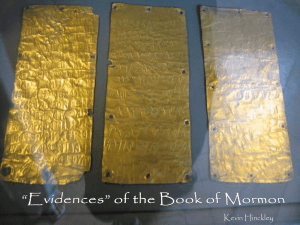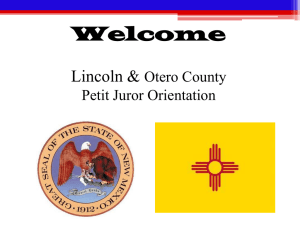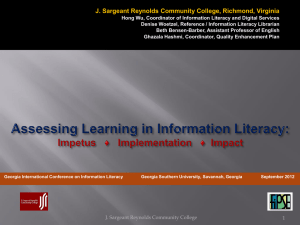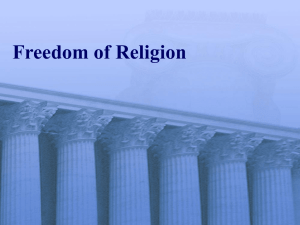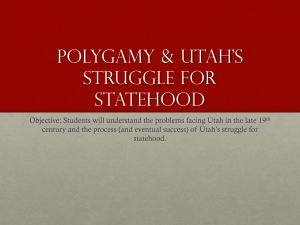Reynolds v
advertisement
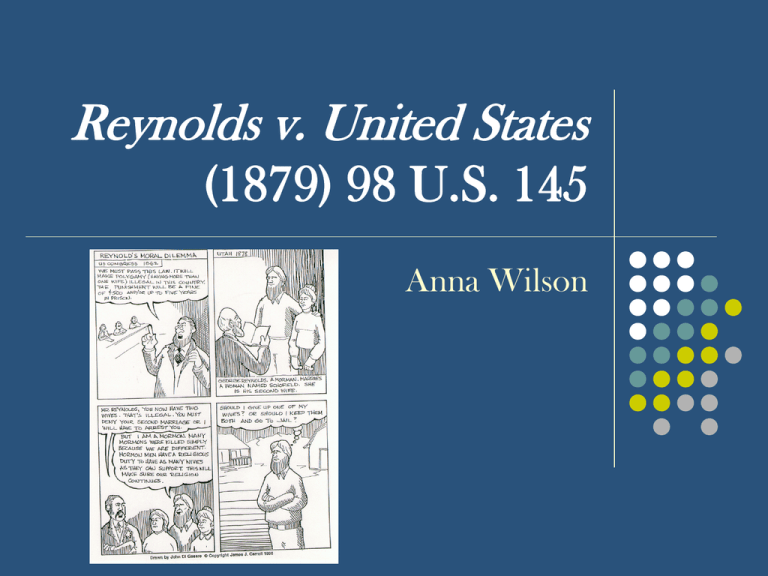
Reynolds v. United States (1879) 98 U.S. 145 Anna Wilson Background In 1847 Mormon refugees fled to the territory that would become Utah in order to escape prosecution In 1852 the Mormon leaders announced their belief in plural marriage by sending a high church leader to Washington D.C. to preach the doctrine1 This caught the attention of the Republican Congressmen, which resulted in the passing of the Morrill Act in 1862 Banned plural marriage 1 Oman, Nathan B. "Natural Law and the Rhetoric of Empire: Reynolds v. United States, Polygamy, and Imperialism." Washington University Law Review 88, no. 3 (January 2011): 661-706. Joseph Smith, founder of the Mormon Church Results of the Morrill Act Utah jurors were unwilling to find Mormons guilty of a crime relating to their religion Federal officials and Mormon leaders decided to test the validity of the Morrill Act by putting forward a defendant to be tried in a case George Reynolds, a newly married polygamist and secretary for Brigham Young, the leader of the Mormon Church “agreed to test the statute and cooperate in his prosecution in return for the government’s agreement not to seek a harsh punishment”2 2 Gillett, Todd M, “The Absolution of Reynolds: The Constitutionality of Religious Polygamy”, 8 Wm. & Mary Bill Rts. J. 497 (2011): 1-39. George Reynolds District Court for the 3rd Judicial District of the Territory of Utah in 1874 This was the first court Reynolds was tried in The courts charged Reynolds with engaging in bigamy for his new marriage to Amelia Jane Schofield while still being married to Mary Ann Tuddenham The attorneys referenced sect. 5352 of the Revised Statutes, which states: “Every person having a husband or wife living, who marries another, whether married or single, in a Territory, or other place over which the United States have exclusive jurisdiction, is guilty of bigamy, and shall be punished by a fine of not more than $500, and by imprisonment for a term of not more than five years”3 3 Reynolds v. United States, 98 U.S. 145 (____). Territorial Supreme Court June 23, 1874 Reynolds argued that the grand jury had been chosen according to federal standards instead of state standards “a grand jury for any district court of the United States must consist of no less than sixteen jurors and no more than twenty-three.”4 Reynolds’ District case only had fifteen Sect. 808 was not designed for territorial courts Reynolds believed that he had proper cause for an acquittal due to a biased jury Charles Read mentioned he had “formed an opinion on polygamy, but did not think it would influence his verdict on hearing the testimony” 5 4Reynolds 5 Ibid. v. United States, 98 U.S. 145 (____). Supreme Court of United States November of 1878 Case was brought forward to examine the Mormon right to polygamy Six main questions to be answered 1. 2. 3. 4. 5. 6. Was the indictment bad because found by a grand jury of less than sixteen persons? Were the challenges of certain petit jurors by the accused improperly overruled? Were the challenges of certain other jurors by the government improperly sustained? As to the admission of evidence to prove what was sworn to by Amelia Jane Schofield on a former trial of the accused for the same offence but under a different indictment The defense of religious belief or duty As to that part of the charge which directed the attention of the jury to the consequences of polygamy Mainly focused on side issues, rather than topic of polygamy First Two Questions The first two questions were presented previously in the Appeals Case Was the indictment bad because found by a grand jury of less than sixteen persons? Sect. 1910 of the Revised Statues states that the district courts of the Territory have the same jurisdiction as regular United States district and circuit courts – but do not have to follow their rules Were the challenges of certain petit jurors by the accused improperly overruled? Arguments over the impartial jurors Read and Ransohoff Court ruled there was no error in their judgement Questions 3 & 4 Were the challenges of certain other jurors by the government improperly sustained? Questions over whether the district attorney is allowed to interrogate jurors over their living in polygamy Arguments stated that there was no way an unbiased decision could have been made with a polygamous-based jury As to the admission of evidence to prove what was sworn to by Amelia Jane Schofield on a former trial of the accused for the same offence but under a different indictment Amelia admitted evidence that was used to indict Reynolds The court ordered a subpoena, but due to a miscommunication she did not appear in court The Final Two Questions The defense of religious belief or duty Reynolds stated that his religion could not be hindered due to the Free Exercise Clause of the First Amendment “Congress shall make no law respecting an establishment of religion, or prohibiting the free exercise thereof”6 Does the government have the power to limit what can be determined as a legal religious act? Without regulation, people could become lawless in the name of a religion As to that part of the charge which directed the attention of the jury to the consequences of polygamy Demoralization of America because of polygamy 6 Gillett, Todd M, “The Absolution of Reynolds: The Constitutionality of Religious Polygamy”, 8 Wm. & Mary Bill Rts. J. 497 (2011): 1-39. Decision & Impact Ruled in favor of plaintiffs (United States) with a 9-0 vote The First Amendment protected religious belief, but it did not protect religious practices that were judged to be criminal such as bigamy Defined the Court’s view on the Free Exercise Clause Influence later cases Goldman v. Weinberger (Jewish pilot who wore unauthorized headgear) and Church of Lukumi Babalu Aye v Hialeah (practiced sacrifice) Opinions Before the trial there was a significant disapproval towards polygamy Resulted in biased jurors Several big name Mormon Court cases occurring at the same time as Reynolds’ trial Brigham Young’s divorce from his wife John D. Lee’s Mountain Meadows Massacre trial Brigham Young John D. Lee Bibliography Ertman, Martha M. “The Story of Reynolds v United States: Federal “Hell Hounds” Punishing Mormon Treason”. http://digitalcommons.law.umaryland.edu/cgi/viewcontent.cgi?article=1525&context=f ac_pubs. (accessed November 13, 2013). Gillett, Todd M, “The Absolution of Reynolds: The Constitutionality of Religious Polygamy”, 8 Wm. & Mary Bill Rts. J. 497 (2011): 1-39. Oman, Nathan B, "Natural Law and the Rhetoric of Empire: Reynolds v. United States, Polygamy, and Imperialism", Washington University Law Review 88, no. 3 (January 2011): 661-706, OmniFile Full Text Select (H.W. Wilson), EBSCOhost (accessed November 14, 2013). Reynolds v. United States, 98 U.S. 145 (1879). Reynolds v. United States, 98 U.S. 145 (___). Smith, Stephen Eliot, "Barbarians within the gates: congressional debates on Mormon polygamy, 1850-1879.", Journal Of Church And State no. 4 (2009): Academic OneFile, EBSCOhost (accessed November 14, 2013). Images Cited Brigham Young. Digital image. Brigham Young Family Association. July 2011. Web. 27 Nov. 2013. George Reynolds. Digital image. Young Men's Mutual Improvement Association, Jan. 2011. Web. 25 Nov. 2013. Gesaro, John DI. Reynolds Moral Dilemma. Digital image. Group2Courtcases.com. 11 Mar. 2012. Web. 24 Nov. 2013. John D. Lee. Digital image. ExecutedToday. 23 Mar. 2009. Web. 27 Nov. 2013. Joseph Smith. Digital image. PBS.org. Web. 24 Nov. 2013.
